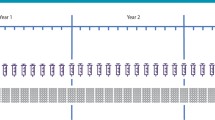Abstract
Immunotherapy by repeated subcutaneous injections of increasing doses of crude extracts of allergens redirects allergic immunologie responses. At first IgE antibodies increase but then they decline slowly. Serum IgG antibodies rise markedly, and secretory antibodies increase modestly. Serum IgG and secretory IgA and IgG antibodies can block in vitro antigen stimulated mediator release by IgE antibody sensitized mast cells and basophils1. After immunotherapy, allergic subjects show reduced immediate responses to allergen challenges to the nasal or bronchial mucosa2.
Access this chapter
Tax calculation will be finalised at checkout
Purchases are for personal use only
Preview
Unable to display preview. Download preview PDF.
Similar content being viewed by others
References
Norman PS. Immunotherapy for nasal allergy. J Allergy Clin Immunol 1988;81:992–996.
Creticos PS, Marsh DG, Proud D, et al. Responses to ragweed-pollen nasal challenge before and after immunotherapy. J Allergy Clin Immunol 1989;84(2): 197–205.
Iliopoulos O, Proud D, Adkinson NF, Jr., et al. Effects of immunotherapy on the early, late and rechallenge nasal reaction to provocation with allergen: Changes in inflammatory mediators and cells. J Allergy Clin Immunol 1991;87:855–866.
Neefjes JJ, Mombouafg F. Cell biology of antigen presentation. Curr Opin Immunol 1993;5:27–34.
O’Hehir RE, Garman RD, Greenstein JL, et al. The specificity and regulation of T-cell responsiveness to allergens. Annual Review of Immunology 1991;9:67–95.
O’Hehir RE, Yssel H, Verma S, et al. Clonal analysis of differential lymphokine production in peptide and superantigen induced T cell anergy. Int Immunol 1991;3:819–26.
Greenstein JL, Morgenstern JP, LaRaia J, et al. Ragweed immunotherapy decreaes T cell reactivity to re-combinant Amb a I. J Allergy Clin Immunol 1992;89:322.
Gaur A, Wiers B, Liu A, et al. Amelioration of autoimmune encephalomyelitis by myelin basic protein synthetic peptide-induced anergy. Science 1992;258:1491–94.
Morgenstern JP, Griggith IJ, Brauer AW, et al. Determination of the amino acid sequence of Fel d I, the major allergen of the domestic cat: Protein sequence analysis and cDNA cloning. Proceedings of The National Academy of Sciences 1991;88:9690–96.
Briner TJ, Kuo M-C, Keating KM, et al. Peripheral T-cell tolerance induced in naive and primed mice by subcutaneous injection of peptides from the major cat allergen Fel d I. Proc Natl Acad Sei USA 1993;90:7608–12.
Norman PS, Winkenwerder WL, Lichtenstein LM. Immunotherapy of hay fever with ragweed antigen E: comparisons with whole pollen extract and placebos. J Allergy 1968;42(2):93–108.
Norman PS, Ohman JL, Long AA, et al. Early clinical experience with T cell reactive peptides from cat allergen Fel d 1. J Allergy Clin Immunol 1994;93:231 Abstract.
Norman PS, Ohman JL, Long AA, et al. Follow on study of the first clinical trial with T cell defined peptides from cat allergen Fel d 1. J Allergy Clin Immunol 1995;95:259 Abstract.
Author information
Authors and Affiliations
Editor information
Editors and Affiliations
Rights and permissions
Copyright information
© 1996 Springer Science+Business Media New York
About this chapter
Cite this chapter
Norman, P.S. (1996). Clinical Experience with Treatment of Allergies with T Cell Epitope Containing Peptides. In: Sehon, A., HayGlass, K.T., Kraft, D. (eds) New Horizons in Allergy Immunotherapy. Advances in Experimental Medicine and Biology, vol 409. Springer, Boston, MA. https://doi.org/10.1007/978-1-4615-5855-2_66
Download citation
DOI: https://doi.org/10.1007/978-1-4615-5855-2_66
Publisher Name: Springer, Boston, MA
Print ISBN: 978-1-4613-7684-2
Online ISBN: 978-1-4615-5855-2
eBook Packages: Springer Book Archive




